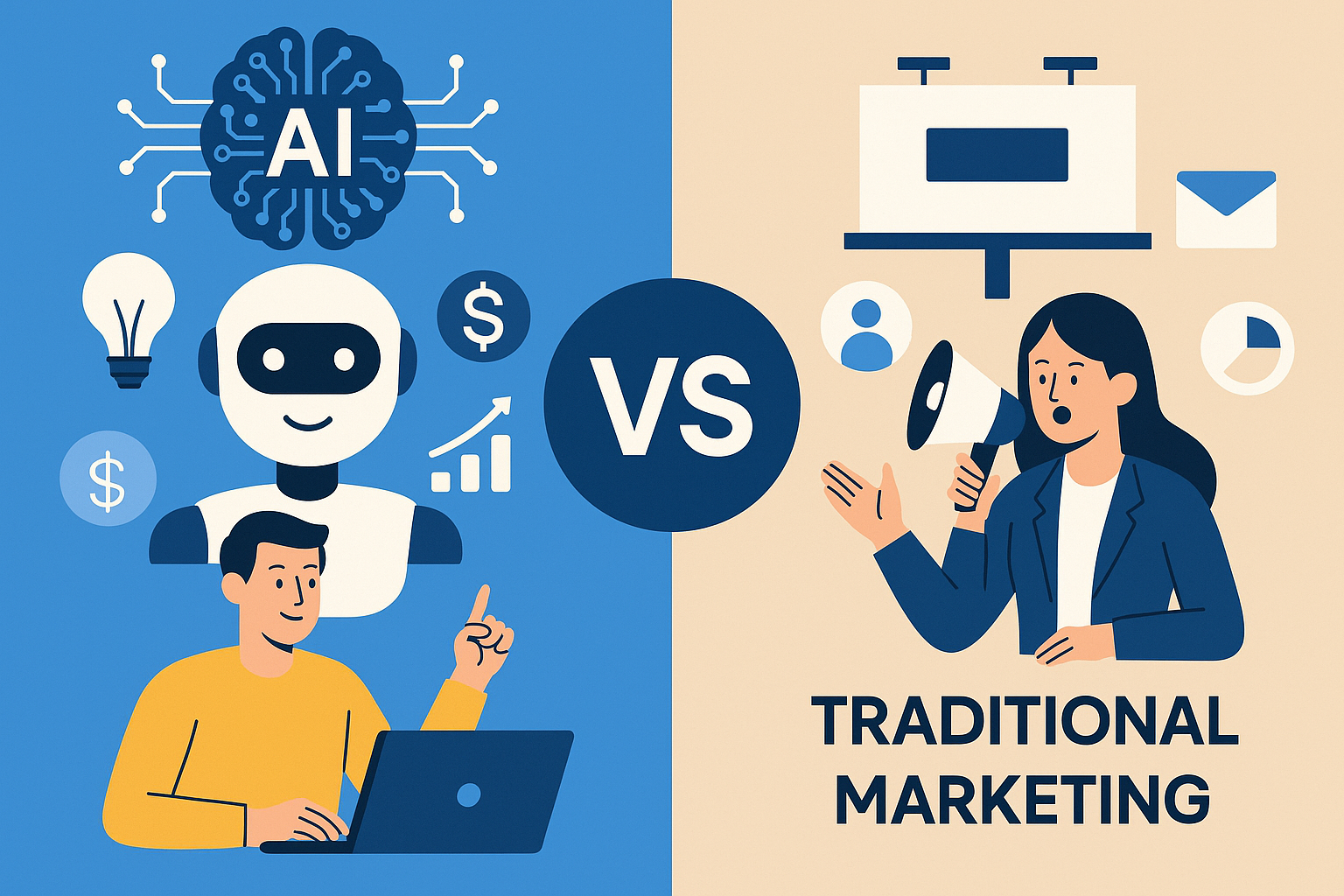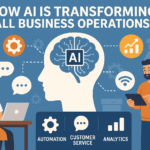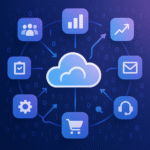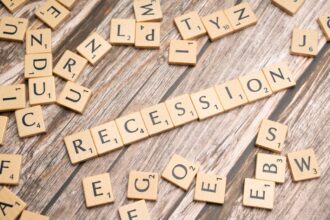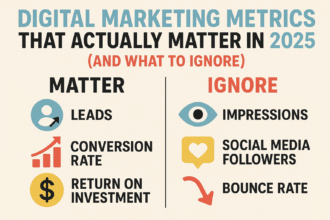AI Marketing vs Traditional Marketing: Which Works Better?
Summary: This 2025 guide compares AI marketing vs traditional marketing—definitions, tactics, costs, KPIs, examples, and a practical hybrid blueprint. Use it to choose the right mix for growth.
Introduction
The question “AI marketing vs traditional marketing: which works better?” matters more than ever in 2025. Artificial intelligence can personalize at scale, predict outcomes, and automate routine tasks; traditional channels still deliver broad reach, trust, and powerful brand storytelling. The right answer is rarely “either/or”—it’s about fit, sequencing, and measurement. This article presents clear definitions, decision frameworks, and current data so you can select (and defend) the mix that maximizes ROI for your market, budget, and timeline.
Bottom line: Use traditional channels to build mass awareness and credibility; deploy AI-powered digital to target, convert, and optimize. A hybrid plan lets each play to its strengths.
Definitions
Traditional Marketing
Traditional marketing includes offline channels such as television and radio spots, print (newspapers, magazines, brochures), out-of-home (billboards, street furniture, transit), direct mail, and in-person events or sponsorships. These media excel at reach, memorability, and trust—especially with audiences less active online or in categories where prestige and mass visibility matter (e.g., automotive launches, national FMCG campaigns, or seasonal retail).
AI Marketing
AI marketing is the use of machine learning, natural language processing, and predictive analytics to plan, execute, and optimize marketing. Typical applications include programmatic ad buying, propensity modeling, churn prediction, dynamic pricing, recommendation engines, content and creative generation, and conversational chatbots or virtual assistants. In practice, AI enhances segmentation, improves timing and channel selection, and automates repetitive workflows from bid management to copy variation testing.
- Planning Forecasting demand, media mix modeling, budget pacing
- Execution Programmatic buying, email send-time optimization, recommendation blocks
- Optimization Multi-armed bandits, uplift modeling, creative optimization and guardrails
AI vs Traditional: Key Differences
| Dimension | Traditional Marketing | AI Marketing |
|---|---|---|
| Reach | Mass—excellent for broad awareness and cultural impact | Targeted—granular segments, cohorts, and individuals |
| Speed | Slower setup, fixed flight dates | Near-real-time testing and adjustments |
| Personalization | Limited; one message for many | High; content and offers adapt by user |
| Measurement | Brand lift studies, MMM, surveys | Clickstream, incrementality tests, MTA, causal inference |
| Cost Structure | Higher production and media minimums | Flexible budgets; automation reduces waste |
| Scalability | Constrained by inventory and slots | Scales across channels, creatives, and audiences quickly |
Tip: You can quantify the trade-off using a media mix model (MMM) and a lift testing calendar. Use MMM for top-down budget allocation and geo-based holdouts for channel-level causality.
Advantages of Traditional Marketing
- Brand Salience & Trust. National TV, print in reputable outlets, and premium OOH carry authority and prestige.
- Shared Cultural Moments. Tent-pole events (e.g., major sports) generate attention that digital alone struggles to recreate.
- Tangible Presence. Physical materials (brochures, packaging inserts) create tactile recall and can drive store traffic.
- Coverage of Low-Digital Audiences. Older or rural cohorts still spend more time in offline media.
- Creative Showcase. Long-form video or striking OOH can establish brand distinctiveness quickly.
Use when: launching a new brand, repositioning, entering new regions, or supporting retail sell-in where buyers expect “above-the-line” support.
Advantages of AI Marketing
- Personalization at Scale. Offers, creative, and timing adjust per user to increase relevance and conversion.
- Efficiency & Automation. Bid strategies, pacing, and experimentation operate continuously, reducing manual overhead.
- Predictive Targeting. Propensity models shift spend to high-likelihood converters and high-value customers.
- Faster Learning Loops. Always-on testing surfaces winners early; poor variants are deprecated automatically.
- Measurability. Digital telemetry supports granular reporting and robust incrementality designs.
Independent estimates suggest generative AI can lift marketing productivity materially when embedded in processes, not just tools.
Limitations & Risks
Traditional
- High fixed costs for production and media
- Longer lead times; less agility mid-flight
- Coarse targeting; limited personalization
- Harder to attribute outcomes without robust test design
AI-Driven
- Data dependencies; quality and coverage matter
- Privacy and compliance obligations (GDPR/CCPA, consent)
- Algorithmic bias and explainability concerns
- Risk of over-fitting or chasing short-term metrics
Balanced governance: establish data standards, experiment protocols, and an AI model review board that validates fairness, safety, and performance.
AI Marketing Trends in 2025
- GenAI-assisted creative ops. Marketers use models to produce variations, enforce brand guardrails, and accelerate approvals.
- Programmatic everywhere. Streaming TV, audio, digital OOH and retail media use AI bidding, frequency capping, and audience modeling.
- From MTA to causality. Teams prioritize incrementality testing (geo holdouts, synthetic controls) as privacy reduces user-level tracking.
- AI in CRM & lifecycle. Send-time optimization, lead scoring, next-best-action, and generative content in email/SMS/WhatsApp.
- Conversational commerce. Chatbots and agents handle pre-sale questions, guided selling, and post-purchase support.
Adoption and impact vary by data maturity, creative volume, and regulatory posture.
Business Case Examples
1) Beverage Brand: AI-Augmented Brand Building
A global beverage brand blended traditional holiday films with digital experiences powered by generative technologies. Traditional spots delivered seasonal reach; AI-enabled digital activations extended engagement online with interactive creative. The lesson: heritage storytelling plus AI-driven participation can compound results.
2) Coffee Retailer: Personalization at Scale
A multinational coffee chain’s internal AI platform optimizes recommendations, labor, and inventory—enabling individualized offers in the mobile app and better in-store execution. Personalization increases frequency; operations data keep experiences consistent across locations.
3) Mid-Market eCommerce: Hybrid Launch Plan
A DTC home-decor brand launching a new line used a one-two punch: (1) regional OOH for credibility and social proof, and (2) AI-driven paid social with creative iteration and product recommendations. Results included higher branded search and a lower blended CAC. The practical takeaway: anchor big moments with traditional media; use AI digital to harvest demand efficiently.
Cost & ROI Comparison
| Line Item | Traditional Marketing (Typical) | AI-Driven Digital (Typical) |
|---|---|---|
| Production | TV spot ($25k–$250k+), print layout, OOH design | Creative variations at scale; GenAI reduces per-asset cost |
| Media | TV/print/OOH buys with fixed flights and minimums | Programmatic/search/social; budgets scalable by performance |
| Targeting | Demographic and geographic | Behavioral, lookalikes, first-party audiences |
| Optimization | Limited in-flight tuning; post-campaign readouts | Continuous bid/creative optimization via algorithms |
| Measurement | Brand lift, MMM, footfall studies | Lift tests, attribution, cohort and lifecycle analytics |
| ROI Expectation | Strong for awareness & consideration; slower payback | Direct response ROI faster; retargeting and LTV compounding |
Benchmarks vary by vertical, margin structure, and creative quality. Use holdout testing to calibrate expectations before scaling budgets.
Measurement & KPIs
Core Formulas
- CAC = Total Acquisition Cost ÷ New Customers
- LTV = Avg Order Value × Purchase Frequency × Gross Margin × Retention Factor
- ROAS = Revenue Attributed ÷ Ad Spend
- Incremental Lift = (Test Conversion − Control Conversion) ÷ Control Conversion
Quarterly Testing Calendar (Example)
| Month | Traditional Test | AI-Driven Digital Test | Primary KPI |
|---|---|---|---|
| Month 1 | OOH geo expansion in 2 cities | Creative iteration (10 variants) with bandit optimization | Brand search lift; CPS (cost per subscriber) |
| Month 2 | Print insert in category magazine | Propensity-scored prospecting vs broad targeting | New customer CAC; 28-day ROAS |
| Month 3 | Event sponsorship (local expo) | Lifecycle email send-time optimization & churn prediction | Lead-to-MQL rate; churn reduction |
Attribution Ladder
- Sanity checks: blended CAC/LTV, channel mix, frequency
- Holdouts: geo, audience, or time-based randomized tests
- MMM: top-down budget guidance and marginal returns
- Causal ML: uplift modeling for next-best-action and targeting
Hybrid Strategy Blueprint
The highest-performing plans orchestrate traditional and AI marketing across the funnel. Use this blueprint as a starting point, then customize to your margin, seasonality, and sales cycle.
- Clarify the job. Is the priority awareness, demand capture, or retention? Align the mix to one lead metric per quarter.
- Prime the market. Run a burst of premium OOH/CTV to seed mental availability and social proof.
- Harvest intent. Deploy AI-assisted search/social with daily experimentation to collect conversions efficiently.
- Compound loyalty. Activate CRM journeys and recommendations. Invest in service chatbots to lower friction.
- Govern with tests. Maintain an evergreen lift calendar; scale only when incremental returns hold.
One-Page Operating System
- North Star: LTV/CAC ≥ 3 for new customers
- Guardrails: Brand search share ≥ prior quarter; Frequency ≤ 6 per week; Creative fatigue index < 1.2
- Cadence: Daily standup; weekly experiment readout; monthly MMM refresh; quarterly strategy review
Suggested Tool Stack (Neutral, No Affiliates)
Data & Identity
- Customer Data Platform (CDP) with consent management
- Cloud data warehouse + BI for unified reporting
- Clean rooms for retailer/publisher collaborations
Activation
- Programmatic DSP for display/video/audio/CTV
- Search & social ad platforms with API access
- Email/SMS/WhatsApp lifecycle orchestration
AI & Optimization
- Recommendation and propensity models
- GenAI content with brand guardrails and human review
- Experimentation platform (A/B, bandits, holdouts)
Measurement
- MMM + calibration with randomized holdouts
- Attribution for digital channels (privacy-aware)
- Brand lift studies for traditional and CTV
Choose interoperable tools; avoid lock-in; prioritize exportable data and clear audit trails for compliance.
Privacy, Compliance & Ethics
- Consent & Transparency. Use clear notices and preference centers; honor regional requirements (GDPR/CCPA).
- Data Minimization. Collect only what drives measurable value; delete or anonymize stale data.
- Responsible AI. Document training data, evaluate bias, and monitor model drift. Keep a human-in-the-loop for decisions affecting eligibility, pricing, or sensitive segments.
- Creative Integrity. Watermark AI-generated visuals where required; maintain brand safety lists and contextual filters.
FAQ
1) Is AI marketing better than traditional marketing in 2025?
It depends on your goal and time horizon. For rapid experimentation and efficient demand capture, AI-assisted digital typically wins on speed, targeting, and measurability. When you need cultural reach, credibility with distributors, or to prime a new market, high-quality traditional placements (premium OOH, print in tier-1 titles, or CTV tent-poles) can deliver outsized awareness. The strongest results come from a hybrid plan that sequences both: traditional to build mental availability, AI digital to convert and retain. Use incrementality testing to verify where each dollar performs best before moving large budgets.
2) What proof is there that AI tools move the needle?
Independent research shows meaningful productivity and value potential when AI is embedded in core marketing workflows (briefing, creative iteration, media optimization, and lifecycle touchpoints). For instance, reputable industry analyses estimate material gains in marketing productivity when generative AI augments existing processes; adoption surveys across 2024–2025 also show marketers actively piloting or using these tools. The caveat: tools alone don’t guarantee outcomes. Benefits show up when organizations improve data quality, redesign processes, and upskill teams in experimentation and governance.
3) When should a small or mid-sized business still invest in traditional media?
Consider traditional buys when you launch a flagship product, pursue retail partnerships that expect “above-the-line” support, or need local credibility (e.g., transit wraps near stores). If margins are tight or the audience is highly niche, start digital-first and add selective traditional placements only after you can attribute a lift in branded search, direct traffic, or retail sell-through. Renting a billboard just to “look big” rarely pays without strong digital follow-through to capture interest while it’s hot.
4) How do I prevent AI marketing from over-targeting and shrinking my reach?
Set frequency caps, rotate broad-reach creatives, and protect budget for discovery campaigns (broad match, interest expansion, contextual placements). Use MMM to estimate diminishing returns at high spend and reserve a fixed share for upper-funnel exposures (e.g., 20–30%). Periodically reset audiences to avoid only hitting known converters; combine modeled lookalikes with contextual signals and creative angles designed for new-to-brand users. Above all, track branded search share and reach alongside conversion metrics so the system doesn’t optimize only to short-term ROAS.
5) What team skills are essential for a hybrid strategy?
Pair classic brand management (positioning, distinctive assets, long-form storytelling) with modern data skills (SQL-lite literacy, experimentation design, causal inference basics) and creative operations. Assign clear owners for (1) data quality and consent, (2) experimentation, (3) performance media, and (4) brand & comms. Upskill copy and design teams to work with GenAI safely and efficiently, and add an internal “AI steward” to document prompts, models, and review criteria. Finally, make finance a partner—agree on incrementality and margin-aware targets before you scale spend.
Conclusion & CTA
The debate isn’t about replacing one approach with the other. In 2025, AI marketing vs traditional marketing is a sequencing and governance question. Traditional channels create reach and trust; AI-assisted digital captures, converts, and retains with precision and speed. Validate the mix with lift tests, monitor LTV/CAC, and keep your creative distinctive.
External References (Selected)
- McKinsey & Company — How generative AI can boost consumer marketing (productivity impact).
- McKinsey & Company — The state of AI in early 2024 (adoption & value trends).
- IAB/PwC — Internet Advertising Revenue Report: Full Year 2024 (US digital spend).
- IAB/PwC (PDF) — Programmatic revenue highlights.
- Salesforce — Top Generative AI Statistics & Marketing Trends & AI (usage signals).
- Coca-Cola — Create Real Magic & Holiday tech experience.
- Hyperight — Deep Brew at Starbucks (personalization platform overview).
Note: These sources inform the discussion in this article. Always consult the latest version for year-over-year updates.
